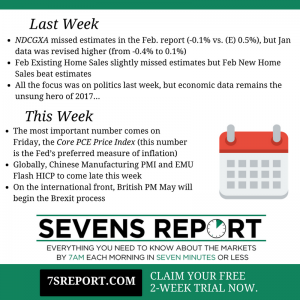Last Week and This Week in Economics, March 27, 2017
“Last Week and This Week in Economics”—an excerpt from today’s Sevens Report: everything you need to know about the markets in your inbox by 7am, in 7 minutes or less.
For all of 2017, better-than-expected economic data has helped to offset the decreased likelihood of pro-growth policies from Washington, and that continued last week as what little economic data we did receive was generally supportive for stocks.
 Looking at Durable Goods, longer-term readers know we ignore the headline and look straight for New Orders for Non-Defense Capital Goods ex-Aircraft (NDCGXA). That is the better measure of business spending, as the headline Durable Goods order is massively skewed by the timing of aircraft orders.
Looking at Durable Goods, longer-term readers know we ignore the headline and look straight for New Orders for Non-Defense Capital Goods ex-Aircraft (NDCGXA). That is the better measure of business spending, as the headline Durable Goods order is massively skewed by the timing of aircraft orders.
NDCGXA missed estimates in the Feb. report (-0.1% vs. (E) 0.5%), but the January data was revised higher (from -0.4% to 0.1%). So, that largely offsets the miss in February.
The March flash manufacturing PMI was a disappointment, as it missed estimates and hit a surprise six-month low at 53.2 vs. (E) 54.3. But while disappointing, the flash PMI forecasted weakness in February that didn’t appear in other national manufacturing PMIs, and even at 53.2, that’s still a decent absolute number (remember, anything above 50 shows activity accelerating). Point being, that one number doesn’t suggest a loss of momentum.
Looking at other data, February Existing Home Sales slightly missed estimates but February New Home Sales beat estimates. But, with housing it’s helpful to step back from the monthly data and observe the overarching trend, and that trend is stability. All the housing data confirms that so far. Higher mortgage rates are now causing a noticeable slowdown in the housing recovery, and that remains key un-sung support for the economy.
Turning to the Fed, there were multiple speakers last week, but the headliner was Fed Chair Yellen, who made no comments about the economy or policy during her speech. Other Fed members were on balance slightly hawkish, as many of them referenced hiking three or four times this year, but none of it was impactful enough to reverse the dollar or Treasury yield decline we’ve seen since the Fed’s dovish hike in March. Markets still have a June rate hike at about a 50/50 proposition, unchanged from last week.
Bottom line, all the focus was on politics last week, but economic data remains the unsung hero of 2017, and it continues to help offset growing policy headwinds via Washington.
This Week
This week will be another relatively quiet week from an economic standpoint, and once again the most important number won’t come until Friday.
That number is the Core PCE Price Index contained in the Personal Income and Outlays report. That’s important because it’s the Fed’s preferred measure of inflation, and if the headline PCE Price Index breaks through 2.0% yoy (last 1.9%), and the Core PCE Price Index moves further towards 2.0% (last 1.7%), that may elicit a slightly hawkish reaction in markets.
Internationally, there are two notable reports to watch. First, Chinese Manufacturing PMI hits Thursday night, and while China remains on the back burner from a macro standpoint, any signs of economic slowing will surprise markets. Second, EMU Flash HICP (their CPI) comes Friday. The best outcome for European stocks is a Goldilocks number, where core inflation doesn’t rise much from the current 0.9% yoy pace, and as such doesn’t make the ECB think about ending QE prematurely. A Goldilocks number will be positive for European ETFs (HEDJ, VGK, EZU).
Bottom line, this will be another quiet week from a data standpoint, but the numbers need to confirm the acceleration of growth to continue to support stocks. From a risk standpoint, too-strong HICP or Core PCE numbers are the events to watch (they might make the Fed and ECB lean more hawkish).
Politically, there will be a lot of analysis on the shift towards tax cuts (we’ll do a primer this week), but nothing truly important is scheduled. Finally, on the international front, British PM May will formally trigger Article 50 to begin the Brexit process (although that shouldn’t cause much volatility).
Help your clients outperform markets with the Sevens Report. Claim your free trial today: 7sReport.com.
